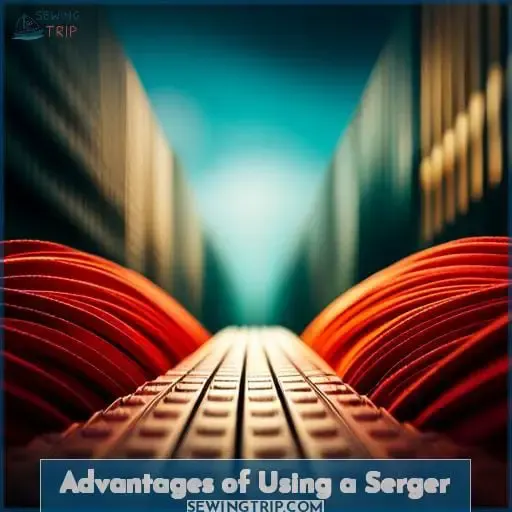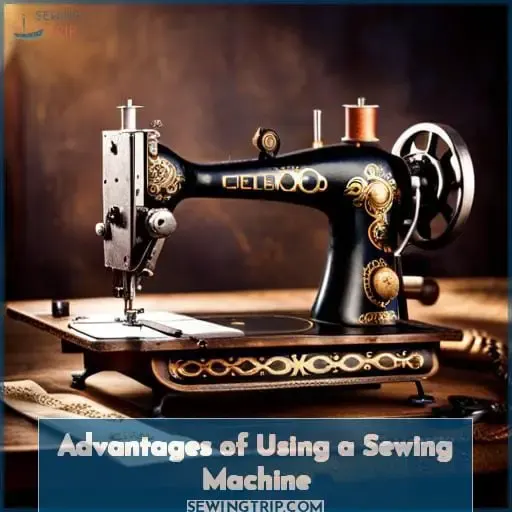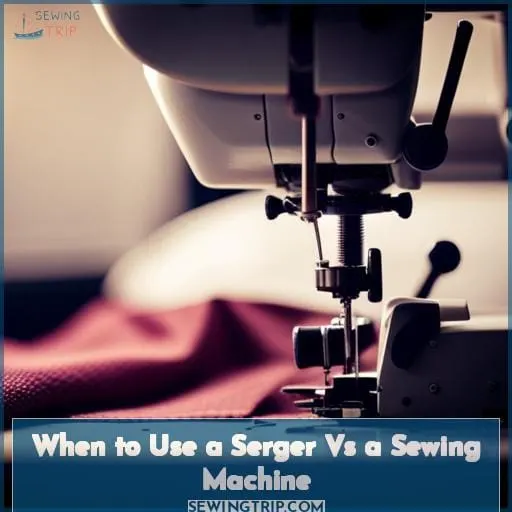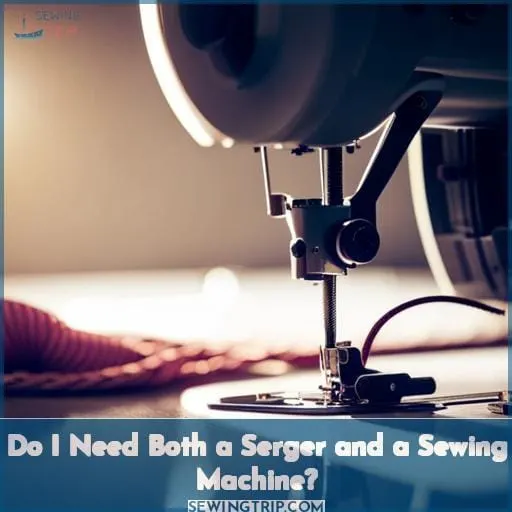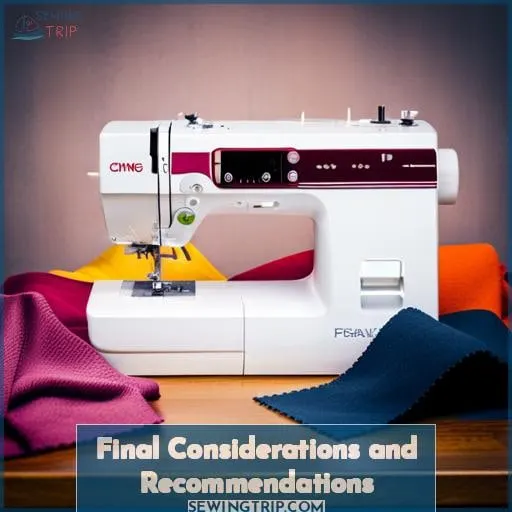This site is supported by our readers. We may earn a commission, at no cost to you, if you purchase through links.
 Imagine finally having the confidence and ability to tackle any sewing project that comes your way. In the world of sewing, understanding the key differences between a sewing machine and a serger is essential for unlocking your full creative potential.
Imagine finally having the confidence and ability to tackle any sewing project that comes your way. In the world of sewing, understanding the key differences between a sewing machine and a serger is essential for unlocking your full creative potential.
From neat finishes to faster stitching, each machine offers unique advantages that can elevate your skills to new heights.
Table Of Contents
- Key Takeaways
- Definition of a Serger
- Key Differences Between a Serger and a Sewing Machine
- Advantages of Using a Serger
- Advantages of Using a Sewing Machine
- When to Use a Serger Vs a Sewing Machine
- Do I Need Both a Serger and a Sewing Machine?
- Final Considerations and Recommendations
- Frequently Asked Questions (FAQs)
- Conclusion
Key Takeaways
- Sergers are specialized sewing machines for neat fabric edge finishes.
- Sergers create professional finishes without pre-cutting and have better stitch quality and durability.
- Sewing machines are more versatile for techniques like buttonholes and offer flexibility and control in sewing techniques.
- The choice between a serger and a sewing machine depends on the project needs and desired finishes.
Definition of a Serger
A serger is a specialized sewing machine that excels in creating neat and professional finishes to fabric edges.
It’s also known as an overlock machine because it binds fabric with an overlock stitch.
Unlike a regular sewing machine, which typically uses one or two threads, a serger uses three or four different threads simultaneously.
The serger not only sews the fabric but also cuts it at the same time, resulting in clean and finished edges.
Its shorter neck compared to a sewing machine allows for better maneuverability when working on projects that require precision stitching along curved edges.
Sergers are recommended for those who want to achieve professional-looking seams quickly and easily without having to spend extra time finishing raw edges manually using other techniques such as zigzag stitching or binding.
Key Differences Between a Serger and a Sewing Machine
Now let’s delve into the key differences between a serger and a sewing machine:
- Serger Benefits:
- A serger offers several advantages over a sewing machine.
- It creates clean and professional finishes, making it ideal for hemming pants or binding fabric edges without the need for pre-cutting or zigzagging.
- Stitch Quality:
- Sergers provide better stitch quality compared to sewing machines when it comes to strength and durability.
- The overlock stitch created by a serger locks threads around seams, preventing fraying and ensuring long-lasting results.
- Serger Speed:
- One of the notable differences is their speed capability.
- Sergers operate at faster speeds than sewing machines, allowing you to complete projects more efficiently.
- Sewing Versatility:
- While sergers excel in edge finishing tasks, they’ve limitations when it comes to versatility in performing various techniques like buttonholes or topstitching that can be easily done with regular sewing machines.
Choosing Between Both Machines
Depending on your specific needs and projects, choosing between a serger and a sewing machine can be a difficult decision.
Advantages of Using a Serger
When it comes to advantages, using a serger offers several key benefits.
First, it creates neat and professional finishes on fabric edges, resulting in a polished look for your projects.
Second, sergers are faster and easier to use for certain tasks such as hemming pants or sewing knit fabrics.
Lastly, the stitch quality of a serger is superior in terms of strength and durability compared to a regular sewing machine stitch.
Additionally, some models even offer the option to turn off the blade when needed for specific projects.
Neat and Professional Finishes
To achieve neat and professional finishes in your sewing projects, using a serger offers distinct advantages.
A serger creates clean raw edges while sewing, resulting in professional-grade binding.
It also provides efficiency benefits with its faster speed and easier operation for various projects.
Additionally, the stitch durability of a serger ensures that your finished pieces will withstand wear and tear over time.
With blade control options, you can choose wisely when to trim fabric or keep it intact for specific projects.
| Advantages of Using a Serger |
|---|
| Professional Finishes |
| Efficiency Benefits |
| Stitch Durability |
| Blade Control |
Faster and Easier for Certain Projects
Get faster and easier sewing results with a serger for certain projects.
Serging benefits include the speed advantage of serger machines, which can sew at higher stitch per minute rates compared to regular sewing machines.
However, it’s important to note that sergers have limitations in terms of their versatility compared to sewing machines. When choosing a machine, consider your specific project needs and essential sewing techniques before deciding between an overlock machine or a regular sewing machine.
Better Stitch Quality for Durability
When using a serger, you can achieve better stitch quality for increased durability.
Sergers are known for their strong and secure stitches, providing excellent seam durability.
The stitching created by a serger is designed to withstand wear and tear, making it ideal for projects that require long-lasting strength.
With precise thread tension control and specialized serging techniques, you can ensure that your finished edges have superior stitch strength.
Whether hemming pants or edge finishing, a serger excels in creating durable seams that will stand the test of time.
Option to Turn Off the Blade
If you’re considering using a serger for your sewing projects, one advantage to keep in mind is the option to turn off the blade.
By turning off the blade, you can prevent it from cutting your fabric while still enjoying the benefits of an overlock sewing machine. This feature allows for more versatility in creating different types of seams and finishes without compromising on professional results.
Advantages of Using a Sewing Machine
When it comes to the advantages of using a sewing machine, there are several key points to consider:
- A sewing machine is suitable for topstitching tasks, providing clean and precise stitches on fabric surfaces.
- Sewing machines offer a longer neck that allows you to work on specific projects with ease and accuracy.
- They allow you to sew on both sides of the needle, offering more versatility in your stitching techniques.
- Sewing machines are ideal for various DIY projects where precision and control are essential.
Suitable for Topstitching
Sewing machines have the advantage of being suitable for topstitching, allowing you to add decorative detailing and precision to your projects.
With a sewing machine, you can achieve clean and professional-looking topstitched finishes on your garments or other sewing creations.
Whether it’s adding decorative accents or reinforcing seams, the versatility of a sewing machine makes it an essential tool for achieving high-quality stitch work in your projects.
Longer Neck for Specific Projects
With a sewing machine, you’ll have the advantage of a longer neck that allows for better visibility and maneuverability when working on specific projects.
The extended neck length provides increased project suitability, giving you more options for different sewing techniques.
Whether you’re working on complex designs or delicate fabrics, the longer neck ensures ease and precision in your stitching.
Recommended models with this feature include the Singer Professional Serger and other user-friendly machines.
Sewing on Both Sides of the Needle
When using a sewing machine, you can sew on both sides of the needle. This allows for greater versatility in your sewing techniques.
With a sewing machine, you have the option to choose different needle options, thread types, and stitch lengths to achieve various effects on your projects. Unlike sergers that are limited to serging only on one side of the needles due to their design features like Brother 1034D or Goldstar Tool machines offer additional functionality with this advantage.
So keep in mind that when it comes to exploring different techniques and having more control over your stitching process, a sewing machine is an invaluable tool.
Versatile for DIY Projects
A sewing machine offers versatility for DIY projects, allowing you to tackle a wide range of creative endeavors.
With a sewing machine, the possibilities for project options are endless. Whether you want to create garments, home decor items, or accessories, a sewing machine is your go-to tool.
It gives you the freedom to explore your crafting possibilities and bring your unique ideas to life through handmade creations.
Let your imagination run wild with the help of a versatile sewing machine!
Recommended User-friendly Sewing Machine
For a beginner like you, it’s recommended to start with an easy-to-use sewing machine that offers versatility for various DIY projects.
A user-friendly sewing machine provides excellent stitch quality and topstitching options, allowing you to achieve professional-looking results.
With project versatility in mind, a sewing machine is the perfect tool for tackling different types of projects and honing your skills.
Compared to sergers, sewing machines offer more flexibility and ease of use for beginners on their journey towards mastery.
When to Use a Serger Vs a Sewing Machine
Now that you understand the advantages of using a sewing machine, it’s important to know when to choose a serger over a sewing machine for your projects.
The decision between serging and sewing depends on various factors such as project selection, desired finishes, and the combination of machines in your arsenal.
A serger excels at creating professional finishes with clean raw edges, making it ideal for garments and projects that require durability. It’s faster and easier to use for certain tasks like hemming pants or high-wear items without the need for pre-cutting or zigzagging.
On the other hand, a sewing machine shines when topstitching detailing is required or if you’re working on specific projects that benefit from its longer neck feature.
By combining both machines in your collection of sewing essentials, you can achieve superior results by utilizing each one’s strengths depending on the task at hand.
Do I Need Both a Serger and a Sewing Machine?
If you’re wondering whether you need both a serger and a sewing machine, it depends on your sewing needs and projects.
Having both machines can offer distinct advantages in terms of stitch versatility, professional finishes, and sewing efficiency.
A serger is particularly beneficial for creating clean raw edges while sewing, making it ideal for hemming pants or eliminating the need for pre-cutting fabric.
On the other hand, a sewing machine is essential for tasks like topstitching or working on specific DIY projects that require longer necks or the ability to sew on both sides of the needle.
While not mandatory to have both machines, owning them offers dual options to achieve different outcomes in your garment-making journey.
Final Considerations and Recommendations
So, you’ve learned about the key differences between sewing machines and sergers. Now it’s time to make your final considerations and recommendations based on your needs and preferences.
Consider whether you need both a sewing machine and a serger or if one will suffice for your projects.
- Stitch options
- Speed
- Versatility
- Durability
- Ease of use
- Cost
Sewing machine or serger?
When deciding between a sewing machine or serger, take into consideration your specific needs and the types of projects you plan to undertake.
Serging basics include creating clean raw edges and hemming techniques.
Consider a serger for its faster speed, better stitch quality, and ability to turn off the blade for specific projects.
A sewing machine is suitable for topstitching and offers versatility in DIY projects.
Choose the right machine based on your project recommendations.
Choosing the right machine
To make the best decision for your sewing needs, consider which machine will provide the most versatility and efficiency in completing your projects.
Think about the scope of your projects, skill level, and budget constraints.
A serger is great for professional finishes and faster hemming on garments.
A sewing machine offers topstitching capability and versatility for various DIY projects.
Assess your requirements to choose the right machine that suits you best!
Pros and cons
Consider the pros and cons of each machine before making a decision. Here are some key points to consider:
-
Pros of Using a Serger:
- Creates clean and professional finishes
- Faster and easier for certain projects
- Better stitch quality for durability
-
Cons of Using a Serger:
- Limited functionality compared to sewing machines
- Can’t replace standard sewing machines for certain tasks
(refer back to Group 3)
-
Pros of Using a Sewing Machine:
- Suitable for topstitching (refer back to Group 4)
Frequently Asked Questions (FAQs)
Can a serger replace a sewing machine for all sewing tasks?
A serger can’t replace a sewing machine for all tasks. While it excels at edge finishing and creating durable stitches, a sewing machine is necessary for precision, versatility, topstitching, and other techniques.
Are there any sewing techniques that can only be done with a serger?
Yes, there are sewing techniques that can only be done with a serger.
Sergers excel in creating professional finishes and durable seams, making them essential for projects like rolled hems and neat edge finishing.
Can a serger be used for quilting projects?
Yes, a serger can be used for quilting projects.
It can create neat and durable seams,
finish raw edges,
and handle multiple layers of fabric.
Adding a serger to your quilting toolkit will enhance your sewing mastery and power.
What are the main differences between a serger and a coverstitch machine?
The main differences between a serger and a coverstitch machine are ironic.
While both offer professional finishes, the serger binds fabric with an overlock stitch and cuts while sewing, whereas the coverstitch machine creates decorative topstitches without cutting.
Can a sewing machine create the same professional finish as a serger?
Yes, a sewing machine can create professional finishes, but it may not match the durability and speed of a serger.
A serger’s specialized features make it ideal for achieving polished edges and efficient stitching in garment making.
Conclusion
To unleash your full creative potential in the world of sewing, understanding the key differences between a sewing machine and a serger is crucial.
While a serger offers neat finishes and faster stitching, a sewing machine is versatile and suitable for topstitching.
Whether you choose a serger or a sewing machine, it ultimately depends on your specific needs and preferences. So, go ahead and embark on your sewing journey with confidence, armed with the knowledge of sewing machine vs serger difference.



